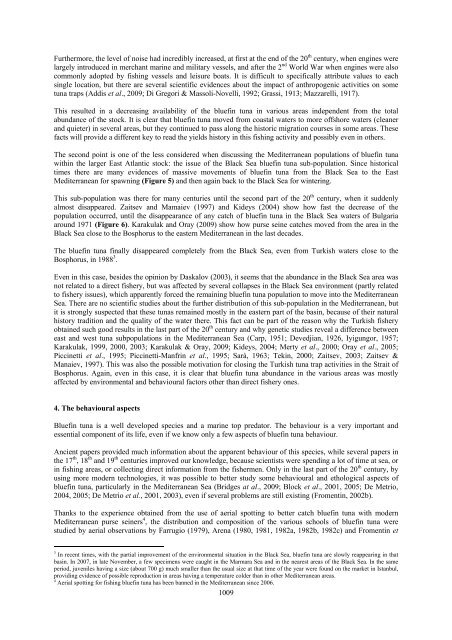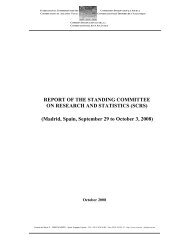SCRS/2009/189 - iccat
SCRS/2009/189 - iccat
SCRS/2009/189 - iccat
You also want an ePaper? Increase the reach of your titles
YUMPU automatically turns print PDFs into web optimized ePapers that Google loves.
Furthermore, the level of noise had incredibly increased, at first at the end of the 20 th century, when engines were<br />
largely introduced in merchant marine and military vessels, and after the 2 nd World War when engines were also<br />
commonly adopted by fishing vessels and leisure boats. It is difficult to specifically attribute values to each<br />
single location, but there are several scientific evidences about the impact of anthropogenic activities on some<br />
tuna traps (Addis et al., <strong>2009</strong>; Di Gregori & Massoli-Novelli, 1992; Grassi, 1913; Mazzarelli, 1917).<br />
This resulted in a decreasing availability of the bluefin tuna in various areas independent from the total<br />
abundance of the stock. It is clear that bluefin tuna moved from coastal waters to more offshore waters (cleaner<br />
and quieter) in several areas, but they continued to pass along the historic migration courses in some areas. These<br />
facts will provide a different key to read the yields history in this fishing activity and possibly even in others.<br />
The second point is one of the less considered when discussing the Mediterranean populations of bluefin tuna<br />
within the larger East Atlantic stock: the issue of the Black Sea bluefin tuna sub-population. Since historical<br />
times there are many evidences of massive movements of bluefin tuna from the Black Sea to the East<br />
Mediterranean for spawning (Figure 5) and then again back to the Black Sea for wintering.<br />
This sub-population was there for many centuries until the second part of the 20 th century, when it suddenly<br />
almost disappeared. Zaitsev and Mamaiev (1997) and Kideys (2004) show how fast the decrease of the<br />
population occurred, until the disappearance of any catch of bluefin tuna in the Black Sea waters of Bulgaria<br />
around 1971 (Figure 6). Karakulak and Oray (<strong>2009</strong>) show how purse seine catches moved from the area in the<br />
Black Sea close to the Bosphorus to the eastern Mediterranean in the last decades.<br />
The bluefin tuna finally disappeared completely from the Black Sea, even from Turkish waters close to the<br />
Bosphorus, in 1988 3 .<br />
Even in this case, besides the opinion by Daskalov (2003), it seems that the abundance in the Black Sea area was<br />
not related to a direct fishery, but was affected by several collapses in the Black Sea environment (partly related<br />
to fishery issues), which apparently forced the remaining bluefin tuna population to move into the Mediterranean<br />
Sea. There are no scientific studies about the further distribution of this sub-population in the Mediterranean, but<br />
it is strongly suspected that these tunas remained mostly in the eastern part of the basin, because of their natural<br />
history tradition and the quality of the water there. This fact can be part of the reason why the Turkish fishery<br />
obtained such good results in the last part of the 20 th century and why genetic studies reveal a difference between<br />
east and west tuna subpopulations in the Mediterranean Sea (Carp, 1951; Devedjian, 1926, Iyigungor, 1957;<br />
Karakulak, 1999, 2000, 2003; Karakulak & Oray, <strong>2009</strong>; Kideys, 2004; Merty et al., 2000; Oray et al., 2005;<br />
Piccinetti et al., 1995; Piccinetti-Manfrin et al., 1995; Sarà, 1963; Tekin, 2000; Zaitsev, 2003; Zaitsev &<br />
Manaiev, 1997). This was also the possible motivation for closing the Turkish tuna trap activities in the Strait of<br />
Bosphorus. Again, even in this case, it is clear that bluefin tuna abundance in the various areas was mostly<br />
affected by environmental and behavioural factors other than direct fishery ones.<br />
4. The behavioural aspects<br />
Bluefin tuna is a well developed species and a marine top predator. The behaviour is a very important and<br />
essential component of its life, even if we know only a few aspects of bluefin tuna behaviour.<br />
Ancient papers provided much information about the apparent behaviour of this species, while several papers in<br />
the 17 th , 18 th and 19 th centuries improved our knowledge, because scientists were spending a lot of time at sea, or<br />
in fishing areas, or collecting direct information from the fishermen. Only in the last part of the 20 th century, by<br />
using more modern technologies, it was possible to better study some behavioural and ethological aspects of<br />
bluefin tuna, particularly in the Mediterranean Sea (Bridges at al., <strong>2009</strong>; Block et al., 2001, 2005; De Metrio,<br />
2004, 2005; De Metrio et al., 2001, 2003), even if several problems are still existing (Fromentin, 2002b).<br />
Thanks to the experience obtained from the use of aerial spotting to better catch bluefin tuna with modern<br />
Mediterranean purse seiners 4 , the distribution and composition of the various schools of bluefin tuna were<br />
studied by aerial observations by Farrugio (1979), Arena (1980, 1981, 1982a, 1982b, 1982c) and Fromentin et<br />
3 In recent times, with the partial improvement of the environmental situation in the Black Sea, bluefin tuna are slowly reappearing in that<br />
basin. In 2007, in late November, a few specimens were caught in the Marmara Sea and in the nearest areas of the Black Sea. In the same<br />
period, juveniles having a size (about 700 g) much smaller than the usual size at that time of the year were found on the market in Istanbul,<br />
providing evidence of possible reproduction in areas having a temperature colder than in other Mediterranean areas.<br />
4 Aerial spotting for fishing bluefin tuna has been banned in the Mediterranean since 2006.<br />
1009

















